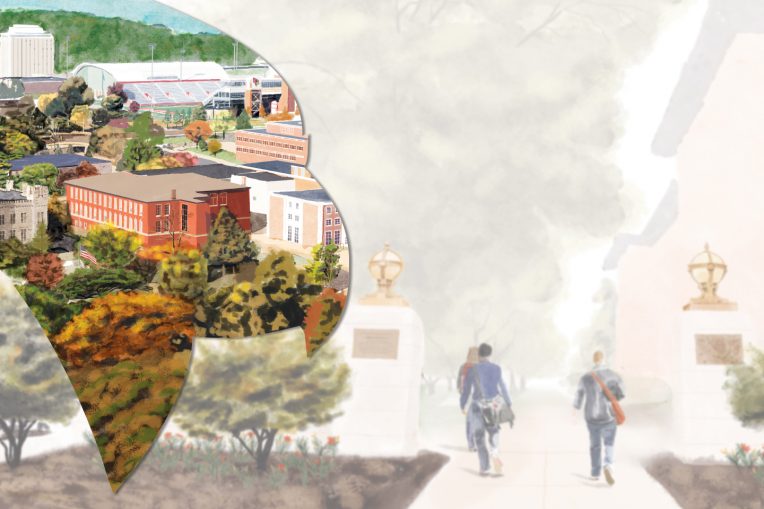Something very subtle and successful has happened in the Office of Admissions. Staff have implemented academic policies, created a system of partnerships, and established an outreach plan so effective that enrollment has shifted. Today one in three students attending ISU is a transfer.
Nearly half of those graduating each year transferred to Illinois State, which is one of only 11 schools nationally to be recognized by Phi Theta Kappa Transfer Honor Roll annually since its start in 2016. The designation identifies four-year institutions that offer exemplary support for community college transfers.
Illinois can boast of transfer success overall. The state leads the nation in the rate of bachelor’s degree completion by community college students who go on to attend a four-year school. Within the state, ISU is a clear leader in connecting with transfer students.
The University enrolls approximately 2,200 transfers annually, with 81 percent coming from community colleges. About a third have an associate’s degree, nearly a fourth are from an under-represented group, and 21 percent are first-generation college students. The cohort has an 89.9 percent retention rate.
“Transfers are becoming a more important population, and ISU has its finger on the pulse,” said Samantha Meranda ’10, assistant director of transfer recruitment in Admissions. She has seen the commitment to the cohort intensify. There are now three people dedicated to working with transfers in Admissions. They all communicate that the different path is understood and respected.
“For many students, it’s a financial decision. During the pandemic, there were those who wanted to stay closer to home. Others are still undecided and recognize community college is a good way to explore options,” Meranda said.
The Admissions team lets these students know ISU has created an easy path for completion of an undergraduate degree. “We work to debunk the transfer misconceptions that credits won’t transfer, scholarships won’t be available, living on campus or studying abroad won’t be an option, and it will take more than four years to finish,” Meranda said.
ISU representatives reach students as early as their junior year of high school to make them aware of Redbird Promise, the University’s guaranteed admission program. It eases the worries of students and their parents as they look beyond the community college years. Redbird Promise states that students who complete an associate’s degree with a minimum 2.4 grade point average will be accepted. The agreement is in place with all 48 Illinois community colleges. ISU’s website details courses needed to transfer and how the process works.
Another contract in place is the Illinois Articulation Initiative. The statewide agreement among most four-year higher education schools and all two-year institutions specifies what general education courses will transfer in specific areas of study including math, the sciences, humanities, and communications.
Even with these contracts in place, communication with community college advisors and high school counselors is critically important throughout the year. Admissions provides updates and showcases facility improvements each year for these influential stakeholders.
“It’s always encouraging to hear our process for transfer students works well.”
Jeff Mavros
Perhaps most important is getting prospective students to campus. They are welcomed for transfer campus visits, which are offered weekly. These include an Admissions presentation and a tour given by an undergraduate who also transferred. They learn of financial assistance available, including up to $3,000 total for two years through the automatic Transfer Student Scholarship. Eligible students must meet grade point average requirements.
“We have Transfer Registration and Orientation Days that are unique. We offer them alongside current student registration so that our transfers have the same course options as our current students,” Meranda said, noting University College coordinates the events.
Social activities for transfer students are offered when the fall semester begins, and there are two transfer-specific registered student organizations. One is Tau Sigma, an honorary society based on academic performance. The other, Transfer Redbirds, helps students acclimate to campus.
“The purpose is to connect students with members of the University, different programs and resources, and advocate for the needs of transfer students,” said Morgan Johnson ’17, who is the group’s staff advisor. Having transferred to ISU from Carl Sandburg College in Galesburg, she understands the challenges of integrating into the University.
“I know as a transfer student, I initially felt like the odd man out,” Johnson said. “There can be false negative connotations that come from transferring, including the mindset that community college students couldn’t get into a four-year school.”
Johnson also knows that transfers may wonder if they will get the same attention as incoming freshmen. “We want them to know they are seen and have the resources to be successful.” Examples include a transfer student seminar and the EMERGE Transfer Student Leadership Program. The eight-week session provides opportunities for leadership engagement, education, and development both personally and professionally.
“I had heard good things about how easy it is to transfer.”
Madison Koustas
All efforts stem from understanding transfer students’ experiences. That knowledge comes in part through the Transfer Council, which includes representatives across campus—from Housing and Financial Aid to academic colleges.
“The group meets monthly to discuss the challenges transfer students face, the resources they need, and how we can improve,” Meranda said. It’s consequently not surprising that ISU “has gained the reputation of doing a good job working with transfer students.”
Madison Koustas was well aware of Illinois State as a student at Black Hawk College. “I had heard good things about how easy it is to transfer. My school promoted ISU too,” said Koustas, who stayed close to her hometown of Geneseo after high school. “I always knew I wanted to come to ISU. Knowing I would get in and everything would transfer eased my first two years.”
Now a senior history education major and tour guide in the Admissions office, she has no regrets but plenty of gratitude. “As a transfer, it’s intimidating. If you live off campus, it’s not as easy to make connections,” she said. “But ISU made it a seamless transition, and I got comfortable very quickly. I’ve been able to get involved without living on campus.”
That’s the kind of experience Director of Admissions Jeff Mavros, M.S. ’06, is determined to create for all transfer students.
“It’s always encouraging to hear our process for transfer students works well,” he said. “When we talk to this group, we commend their decision and emphasize that their degree will say Illinois State just as it does for those who enroll as freshmen.”
Mavros is proud of his staff and the University’s overall commitment to transfer students, noting recruitment and retention is the job of everyone on campus. While other schools take a more passive approach, he anticipates that ISU’s active process to enroll transfer students will continue and improve.
“We make transferring easy to understand, and we attempt to eliminate barriers and alleviate concerns. We want our transfers to go to their community college with a plan, knowing they can finish a degree at Illinois State,” Mavros said. “We do a better job of this than some of our peers, and the results speak for themselves.”
Colleges remove transfer student obstacles
Transfer students who come to ISU are guaranteed admission to the University through Redbird Promise, however, that does not mean they will be automatically enrolled in a desired major. Some academic programs have additional requirements that must be met, which is why more work has been done at the college level to make programs accessible.
The College of Education (COE), for example, collaborated with Chicago Public Schools and the City Colleges of Chicago on the Teach Chicago Tomorrow teacher pipeline initiative, which is part of a long-term strategy to prepare teachers for Chicago schools. Students transfer to Illinois State after completing an associate’s degree at a Chicago community college.
COE also has articulation agreements with community colleges in Chicago, Peoria, and rural areas in central Illinois. The result is a smooth and transparent pathway to completing a teaching degree at ISU.
“We develop a relationship with the directors of the community college nursing program and work with them for recruitment of their students to MCN.”
Dr. Catherine Miller
Mennonite College of Nursing (MCN) is among ISU’s most competitive programs, with approximately 1,600 freshman applicants annually for 150 openings.
Enrollment averages around 800, with 25 percent of the spots kept open for students transferring in as a junior to the pre-licensure program.
One option for community college transfers is the Pathways Program, which exists because of partnerships MCN has created with 17 community colleges across the state. Students have dual admission to the college’s online RN to BSN program when they are enrolled in the nursing sequence at a community college and have been accepted at ISU.
Transfer requires completion of the associate’s degree in nursing with a C average and a passing grade on the national licensure exam. MCN will hold a student’s application for two years. The bachelor’s degree can be completed in 12 months with full-time attendance or 24 months if done part-time. The program is fully online.
A second option is dual enrollment, which allows students who are completing a two-year nursing degree to start working toward a bachelor’s degree by taking courses through MCN simultaneously. There are 13 community college partnerships in place for this online program.
Dr. Catherine Miller played a leading role in creating the agreements when she served as interim dean for the college from 2014 to 2016. She was also on the nursing faculty at Heartland Community College, where she served 11 years as associate dean of the nursing program prior to joining MCN in 2010 as associate dean for academics.
Retired from MCN, she continues in the role of external partnership liaison for the college, working with Dean Judy Neubrander in pursuing additional community college partnerships and updating those in place.
“We develop a relationship with the directors of the community college nursing program and work with them for recruitment of their students to MCN,” Miller said. “We want students to go on to get the bachelor’s degree. That is what is important for the nursing profession.”
Miller is pleased with MCN’s efforts, noting former President Larry Dietz joined her and Neubrander for the signing of agreements at community colleges to celebrate the partnership. Students are the ultimate beneficiary because they are able to complete a degree that empowers them to provide better care and advance in their field.



